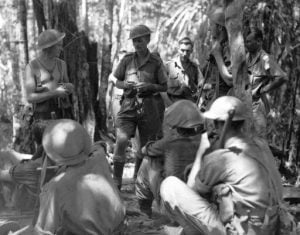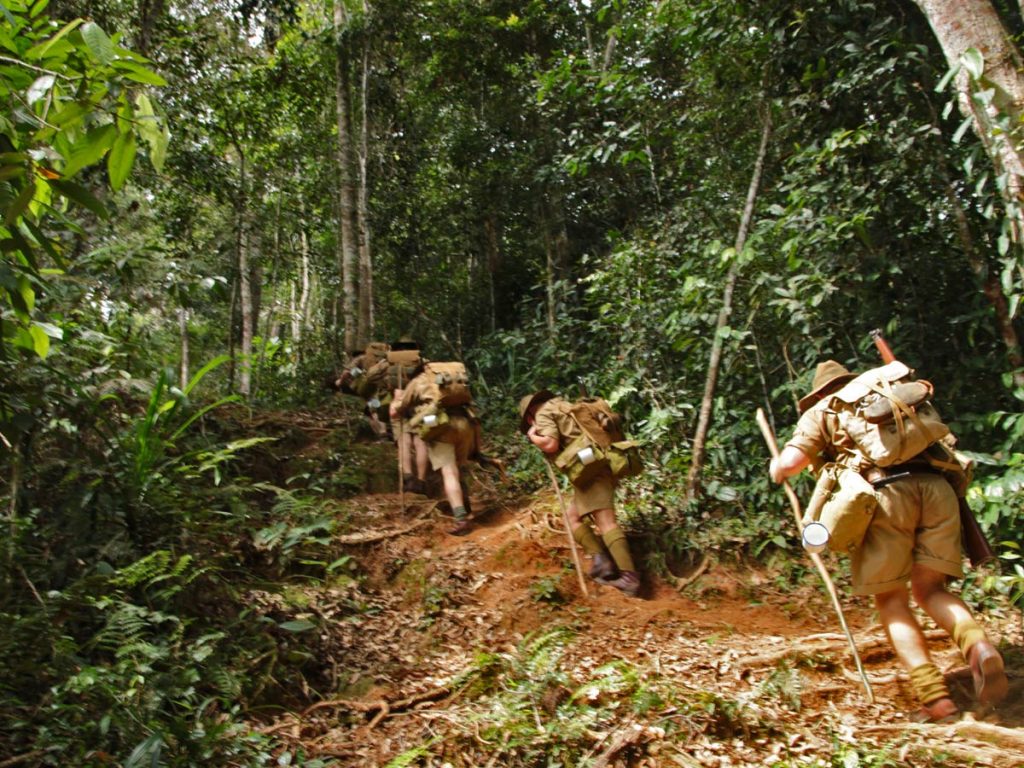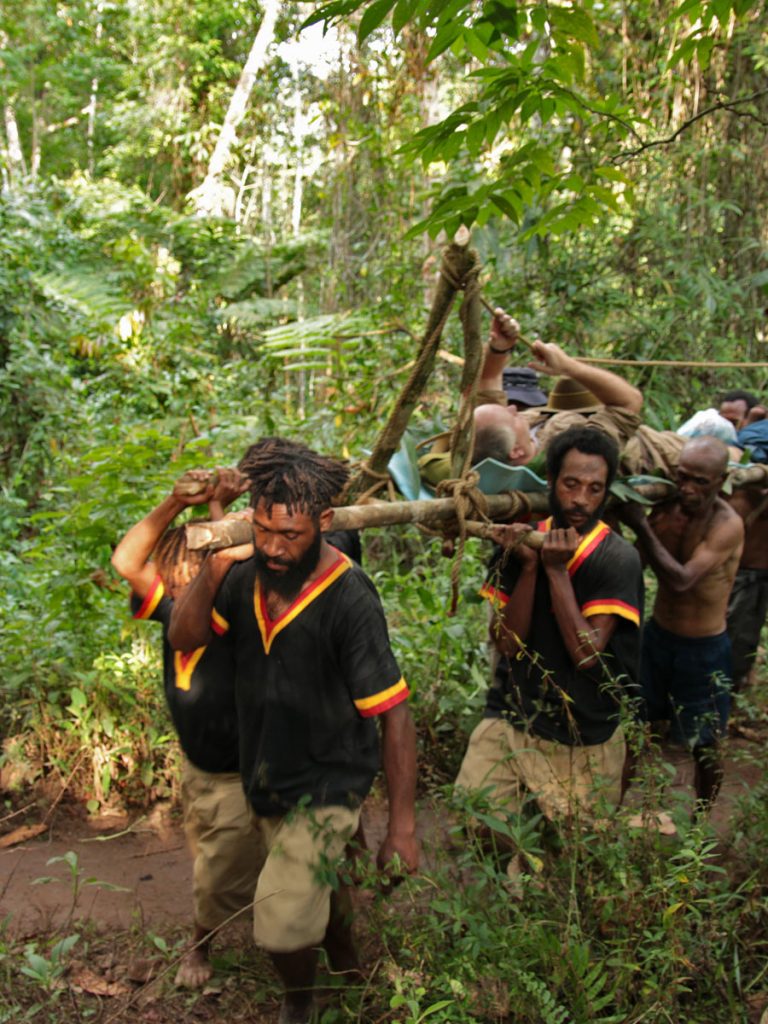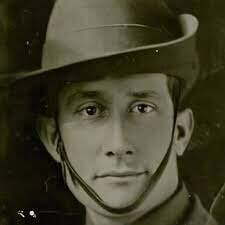ALONE AND SURROUNDED
The Second Battle For Kokoda
By Captain Andrew Flanagan
Following the death of LTCOL Owen, 33-year-old MAJ Allan Cameron, a lawyer from Elwood in Victoria, desperately rushes forward along the Kokoda Track in order to take command of the soldiers of the 39th Battalion. Cameron, an experienced Army officer, had escaped the Japanese after their invasion of New Britain, avoiding the Japanese massacre of 160 Australian soldiers at the Toll Plantation. He is the new commander of the 39th Battalion, strung out along the Kokoda Track pushing forward to join the battered soldiers of B Company, perched on the high ground overlooking Kokoda, at the small collection of native huts known as Deniki.

At midday on 30 July CAPT Arthur Dean and his men of C Company, 39th Battalion, arrive at Deniki with crucial supplies, including ammunition – but more importantly, additional men to reinforce the small number of B Company survivors of the Kokoda battle. CAPT Dean pushes some of his men forward towards Kokoda, including 22 year-old Lance Corporal Kevin Whelan, to provide a buffer should the Japanese attack. CPL Whelan is issued with a Bren machine gun – he had never seen one before, and didn’t know how to operate it – and ordered to hold off the Japanese while the rest of the 39th Battalion move ‘up the Track’. By 1 August A Company had arrived at Deniki, using their helmets to ‘dig in’ on the high ground. When Kokoda was clear of clouds, they could see the Japanese entrenched at Kokoda, holding the vital airstrip – use of the airstrip would allow whoever held it to fly in men and supplies, avoiding a long walk from either Port Moresby (Aus) or Buna (Japanese).
MAJ Cameron arrives on 4 August. He now had a strong force dug in at Deniki, but despite this he had a number of significant issues – B Company, worn out after weeks of running battles with the Japanese, and bloodied during the first battle at Kokoda had been joined by A, C and D Company, men exhausted by their rush up the Kokoda Track, and untested in battle. Cameron held the high ground, but not the airstrip, meaning that his supplies would have to be carried in, and any wounded would have to be carried out. Perched above Kokoda, he had no idea how many men the Japanese had, but he assumed their intent – hold the airstrip, rapidly advance along the Kokoda Track to Moresby, destroying any Australian forces strung out along the track, and in doing so take PNG. Should PNG fall, Australia would be isolated.
MAJ Cameron needed a plan, and fast! Deniki was a strong defensive position, but sitting there and waiting for the AIF was not an option – his men could be easily surrounded, and it was obvious that the Japanese were rushing forward fresh troops, supported by heavy machine guns and mountain artillery. Sitting and holding Deniki would merely delay the inevitable, with the Japanese able to pound his men from a distance, surround them, and wipe them out. Cameron had to take Kokoda, and fast. And once taken, it had to be held, and higher command in Moresby successfully contacted and notified that troops could be flown in. His troops were patrolling forward of Deniki, and running into Japanese patrols probing his positions. For MAJ Cameron, the clock was ticking – be fixed at Deniki holding the Japanese while the AIF advanced up the track, and wiped out over time, or go on the attack, regain the initiative, retake Kokoda and push the Japanese back to the northern beachheads. In reality, Cameron has only one option – attack.
Sounds quite simple, really – but gathering his company commanders, MAJ Cameron quickly realised that nothing was simple along the Kokoda Track! Any attack would have to happen quickly, taking the Japanese by surprise. Any advance would have to happen in daylight, due to the severe terrain and frequent torrential rain at night. His troops would need to rush the 8kms on a single-file track, crossing a number of streams and likely ambush sites. To make the impossible more difficult, there were multiple ‘tracks’, allowing the Japanese to move forward and attack his troops from the side (the ‘flanks’) as soon as his attack was detected. Assessing that there were around 500 Japanese at Kokoda, with another 150 troops close by, MAJ Cameron had only around 300 Australians (three companies – A, C and D) to attack and hold Kokoda. His plan was high-risk, high-reward. He would need to split his companies, with A Company to attack along the main track, with C Company protecting the left flank and attacking Kokoda from the west. Meanwhile, D Company would advance on the right, blocking any Japanese forces attempting to reinforce Kokoda. His company commanders opposed Cameron’s plan, concerned about diluting the attack of a smaller force against a larger, dug in enemy. If either of his three companies were engaged by the Japanese and stopped, his attack would be further diluted and open to attack from the front and side. MAJ Cameron’s risk-reward strategy would likely result in one of two outcomes – his troops would be wiped out one company at a time, or they would take the Japanese by surprise in Kokoda, and defeat them, regaining the airstrip. Cameron had been ordered to retake Kokoda, and he had no choice but to split his force – the success or failure of the attack would rely on luck, and everything going to plan.
At 0630 on 8 August D Company left Deniki to secure the right flank, followed by A Company down the central track at 0700, and C Company at 0730.
At 0330 that same morning, Japanese Lieutenant Onogawa and his men had left Kokoda to attack the Australians at Deniki, pausing at dawn on a small hill overlooking the main track, searching for any Australians.


On the right flank, D Company initially made good progress, however were engaged by a number of Japanese as they neared the village of Pirivi, delaying their advance for over an hour. 21-year-old PTE Leslie Balfour was killed, while three others were wounded, including 34-year-old LT Hercules Crawford who had been shot in the helmet, forcing jagged edges of the helmet into his head. Refusing help, the badly wounded LT Crawford drew his pistol and started back towards Deniki. He would not make it, either killed by the Japanese or dying alone in the jungle – his body has never been recovered.
Arriving at the Kokoda-Oivi ambush position – late due to running into the Japanese – D Company were soon under attack by a strong Japanese force advancing towards Kokoda. Not long after, they were attacked by a Japanese force reacting from Kokoda, meaning that they were engaged from the east and west! D Company, meant to be a blocking force, were effectively surrounded and at risk of being wiped out.
Meanwhile, advancing along the central track, A Company – with Papuan Lance Corporal Sanopa in the lead – approached Kokoda. Pausing in the jungle while an attack of P-39s bombed the plateau, the men would have been encouraged by the sight of Sanopa, with his collection of Japanese ears strung between jungle vine testimony of his courage. As the Australian aircraft clear, A Company push into Kokoda to discover it largely unoccupied of Japanese, as they were themselves pushing along alternate tracks to attack Deniki. They would discover the body of LTCOL Owen, dumped in a slit trench, and shoot a single Japanese soldier, caught in the act of pumping up his bike tyre. Amazed at their fortune, A Company dig in along the plateau, knowing that once their presence was discovered the Japanese would have to break off their planned advance on Deniki, and return to attack Kokoda.

52-year-old Sergeant Jim Cowey, a World War 1 Gallipoli-Western Front veteran, is sent with a patrol across the airstrip to fire a signal flare, alerting MAJ Cameron that Kokoda had been taken and thereby triggering reinforcements flown from Moresby. One might wonder what SGT Cowey thought, having served through WW1 only to find himself standing on an airstrip in Kokoda, surrounded by men young enough to be his children, and further surrounded by the men of his WW1 ally, Japan. Undoubtedly, the inexperienced boys of A Company would have been encouraged by having SGT Cowey nearby. The flare, fired in the afternoon light, explodes above Kokoda….and is not seen at Deniki. It may, however, have been seen by the Japanese advancing towards Deniki. Whilst A Company have taken Kokoda, they now have to hold it.
Covering the western flank, CAPT Dean and his men of C Company approach Faiwani Creek, meeting a patrol of Australians who inform them that a significant number of Japanese are dug in on the other side of the creek. The forward Japanese positions are quickly engaged, with seven Japanese killed, however the quick attack is held up by a Japanese heavy machine gun. It is now almost midday, the time that C Company was expected to be attacking Kokoda with A Company, and they were instead blocked by an unknown Japanese force, supported by machine guns and mortars. CAPT Dean, moving across the creek to organise another quick attack in order to gain the initiative, is shot in the stomach and killed. Despite withering fire from the Japanese across the creek, he is buried in location – his body would be recovered in the 1960s. The men of C Company rush forward to engage the Japanese, knowing that unless they clear the Japanese A Company will be left to attack Kokoda alone. However, C Company had met the main body of Japanese launching their own attack on Deniki, and the Australians were outnumbered at least three to one. Quickly realising that it was impossible for C Company to clear the Japanese, MAJ Cameron orders the men to withdraw back to Deniki. At the plateau, the men of A Company hear firing from their right and left flank, and realise that they are all alone, with night rapidly approaching……along with hundreds of confused Japanese!
Japanese LTCOL Tsukamato reels in shock – he had been comfortable planning an advance on the Australian soldiers at Deniki, only to now discover his attacking force themselves being attacked on two flanks, and unconfirmed reports of Australians BEHIND him in Kokoda, holding the airstrip. Splitting his troops, some follow C Company to Deniki and engage the Australians while the rest of his soldiers rush back to Kokoda. Darkness falls – the unique PNG darkness, pitch black – as the Australians and Japanese exchange shots at gun flashes. MAJ Cameron is forced to use his HQ staff to reinforce C Company. His high risk, high reward plan is unravelling quickly.
Dawn the next day finds D Company making their way back to Deniki, having extracted themselves from the Japanese on the Kokoda-Oivi road, rushing to join C Company as the only significant Australian force dug in on ‘defendable’ ground between the Japanese and Moresby. Attacks on C Company continue at first light. About this time, CPL Sanopa returns with news of A Company, still holding Kokoda, and requests for reinforcement and resupply – each A Company soldier having gone into battle with just two days rations, 100 rounds of ammunition and two grenades. However, MAJ Cameron was in no position to help the men of A Company, given he was under attack himself, and he was out of contact with both Moresby, and Kokoda. Around 11 a.m, his problems become significantly more complex – he hears a barrage of rifle and machine gun fire erupt around Kokoda itself.
At around 11 a.m LT Neal, commanding 9 Platoon A Company dug in at the base of the track between Deniki and Kokoda, observe around 100 men camouflaged with vegetation and covered in mud moving carefully through the rubber plantation towards his position. A sense of relief, expecting that these are the men of C Company moving to reinforce his meagre force, is replaced by fear at the realisation that they are Japanese. The Japanese, supported by machine guns and mortars, launch a number of attacks on the young, heavily outnumbered and out-gunned Australians. The Australians hold their ground. Their mates crawl across the plateau in order to reinforce them, bringing forward ammunition and dragging out the wounded. Twenty-year-old PTE ‘Bluey’ Williams is shot in the head, as is 25-year-old CPL Frank McLeod, both killed by a Japanese sniper shooting from a rubber tree. The Australians are pinned down, and being swept by waves of Japanese fire.
One of those Japanese sweeping fire across the Australian position was LT Hirano Kogoro, having advance through the rubber plantation and attacked at 11 a.m. Unable to break through as a result of the intense Australian fire, LT Kogoro crept forward through driving rain, attempting to close with the tenacious Australian defenders. Around 2 p.m a further assault took its toll on the Australians of 9 Platoon; in seven attacks every single one of these men would be killed or wounded, with the wounded remaining in their shallow weapons pits to fight on, knowing that if 9 Platoon broke, the position would fall. At 4 p.m an attack of around 200 Japanese assaulted 7 Platoon, on the western lip of the plateau, supported by machine guns and mortar fire. Failing to break through, the Japanese switched to the northern and eastern parts of the line – once again failing to break through. As darkness came, so did the Japanese, creeping in amongst the Australian positions. A number of the Australians were killed, their throats cut. It is easy to imagine the terror felt by these young militia, most in their first battle – steadied by the presence of SGT Cowey, and the calmness of their Officers.
10.30 p.m.
LT Kogoro and his men creep on hands and knees towards the Australians. An Australian forward sentry is brutally bayonetted, however the Japanese charge into a wall of rifle fire, scattering the Japanese who become lost in amongst the rows of rubber trees, pitch darkness and pouring rain. Taking the wrong direction, the Japanese accidentally close on an Australian position, where they are repulsed with hand grenades, losing many killed and wounded. A further attack at 3 a.m is defeated, however the Australians were quickly running out of ammunition, grenades and food…..and incurring a rapidly increasing number of killed and wounded.
Throughout the night, fresh Japanese troops rush forward towards Kokoda, and more and more Japanese soldiers creep through the Australian position, identifying weak points and engaging the Australians where possible, denying the exhausted Australians any rest.
10 a.m, 10 August, around 200 Japanese attack, closing with the Australians who repulse them in vicious hand-to-hand fighting. The heavily reinforced Japanese launch another attack at noon, while a single Australian fighter aircraft circles overhead. The appearance of the aircraft worries the Japanese, who fear that the Australians will fly in men and ammunition and it will then be the Japanese who are surrounded. Equally, the aircraft frustrates the defending Australians, as it neither attacks the Japanese, or drops supplies. However, the Japanese know that they must take Kokoda that day, with a massed all-round assault on the thinly-held line. On dusk around 300 Japanese burst from the jungle, supported by machine guns, mortars and mountain guns lobbing high-explosive and smoke shells onto the plateau. Rapidly closing to within metres of the Australians, hand-to-hand fighting resumes. One Australian, 18 year-old PTE Ken Troeth, is shot in the shoulder, jaw and hand. Making his way to the aid post, he is given a blood transfusion and bandaged up. Shortly after, he returns to his position, not prepared to leave his fellow Australians fighting for their lives. Australian wounded would rather fight on in their positions, and be killed, than leave their mates alone. The Japanese attack is stopped, once again, by the small force of less than 100 Australians. Night falls. A Company continues to grimly hold Kokoda, now into the third day, low on ammunition, and waiting for reinforcements that would never come. Men from A Company headquarters crawl to the forward weapons pits, under fire, bringing cooked Japanese rice and the very last of the ammunition.
Knowing that to remain any longer would see A Company wiped out completely, a withdrawal is ordered for 7 p.m., with the remaining men of 7 Platoon leading the breakout. 8 Platoon would follow, bringing the wounded, while 9 Platoon would remain behind for as long as possible to engage the Japanese, trading their lives for time to allow the wounded to escape a certain death. Those wounded who could not walk were carried on blankets, leaving 9 Platoon alone just as the Japanese launched yet another attack. World War 1 veteran SGT Jim Cowey volunteers to stay behind with 9 Platoon.
A lull in the Japanese assault allows 9 Platoon to disengage, covered by Jim Cowey, kneeling in the darkness, his rifle held steadily at his shoulder. They hear the Japanese in the darkness, rolling grenades into weapon pits and bayonetting already dead Australians. Knowing that running would draw Japanese fire, SGT Cowey instructs the rear guard of A Company to calmly walk out of Kokoda and across the airstrip, hooking around towards Deniki.
Kokoda, and its critical airstrip, was once again in Japanese hands.


